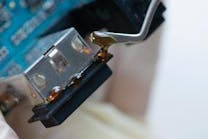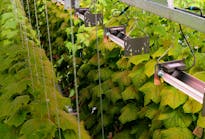Date Announced: 12 May 2010 Heraeus has entered the stage front-on with its Stamped Circuit Board technology – a fully comprehensive concept for thermal management. Basically, it means that heat can be drawn away from beneath the chip far more quickly, reliably and cheaply. A series of tests at the Fraunhofer IZM confirm that the technology contains an enormous amount of potential. Stamped Circuit Board (SCB) technology combines structured layers of metal and plastic for use in substrate assemblies, e.g. of LEDs. Similar to printed circuit boards, this layering may consist of fiberglass-reinforced epoxy resin and copper – however, the separate structuring of the two materials opens the way for totally new design concepts. During the manufacturing process both the plastic and the metal are initially treated on separate reels and structured according to the specific requirements involved. At the next stage, the materials undergo lamination after which they are left perfectly aligned to each other. Advantages of SCB technology Light flux, efficiency and durability of LEDs depend very much on the junction temperature of the actual LED itself. A rising component temperature has a negative effect on the service life and efficiency of the product, and therefore an intelligent form of thermal management is a matter of extreme importance. Acting as chip carrier, SCB technology makes a key contribution favouring the electrical and thermal properties. In addition, the use of many different metals respectively alloys takes on a central role in regard to heat dissipation. SCB is fully based on a reel-to-reel concept (R2R) concept. This offers great possibilities to automate the production, which in turn leads to low manufacturing costs. Furthermore, in view of the large variety of materials and geometric variants new solutions arise with respect to thermal management.User value:a) Production process "reel-to-reel": high productivity due to level ofautomation, and subsequent low costsb) Versatile stamping technology: the materials can be inflected and stamped and the resulting shape stabilizes the substrate and fixates the lenses. Stamped cooling ribs can also be produced, and contacting can be done at varying levels (= reduction of frame size).c) Open choice of many different materials and thicknesses: in line with the application the most cost-optmized material can be selected.d) Simpler operation: thanks to the R2R concept the manufacturing process is much easier to handle for the operator (as opposed to standard technologies). e) Quicker separation: after being stamped, only very thin ribs of the material maintain the structures, and thus the parts can be readily separated/divided. Success confirmed by testsThe Hanau materials and substrate expert does in fact possess enough in-house know-how to cover the entire spectrum of AVT production, but feedback from an independent outside source was sought to demonstrate just what can be achieved with SCB technology. The Fraunhofer Institute IZM was invited to participate. The main topic of exploration was the heat transfer behavior of LED systems based on simultaneous stamping/laminating technology (SCB) in comparison to conventional technologies. The experts considered 3 substrate solutions for the HB module assembly: Printed Circuit Board, injected molding composite (over-molded stamped parts), and Stamped Circuit Board. Following thermal analysis the substrates were scrutinized with close attention being paid to amongst other things, the structure, the overall materials, and the Thermal Interface Materials (TIM).Additionally, factors influencing thermal management were examined, placing special emphasis on: 1. the LED chip itself (structure, dimensions, binning)2. the LED chip mounting (type of connection: conductive adhesive, soldering, silver-sintering etc.)3. the printed circuit board connection (dimensions) and 4. the substrate (technology, materials and dimensions).In the final instance it was shown that SCB technology has a wealth of potential in regard to thermal management when compared to conventional technology. ConclusionThe sophisticated thermal management provided by SCB technology leads to an increase in service life and efficiency. Moreover, tangible manufacturing characteristics are also in the main focus of this technology. The reel-to-reel process raises the degree of automation and increases productivity, thereby reducing costs. Because structuring is done separately it enables an optimization of material and design and an exploitation of the individual positive properties of each and every material! It all depends on whether it is more important to influence the overall thermal capacity (short-term applications) or influence the thermal spread (long-term applications). Through the sum of the positive properties the module retains a "cool head", costs sink and the light yield increases.
Contact
Tom Grunwaldt Marketing & Communication Services W. C. Heraeus GmbH Heraeusstraße 12-14 63450 Hanau, Germany Phone: + 49 (0) 6181.35-5433 Fax: + 49 (0) 6181.35-3131
E-mail:[email protected]
Web Site:www.heraeus.vom






